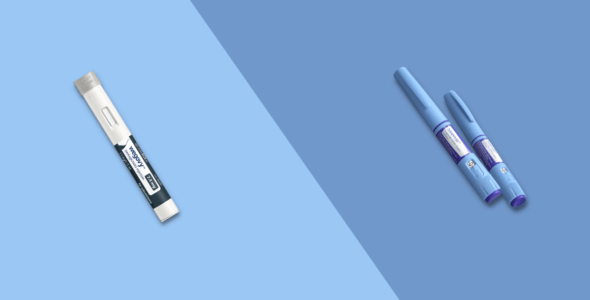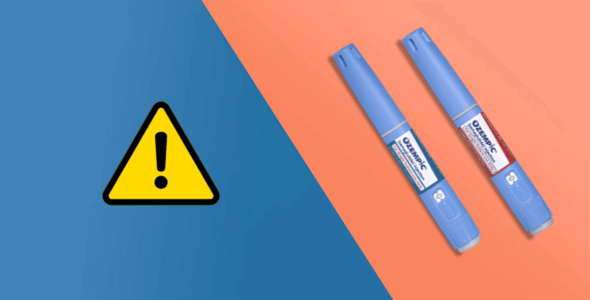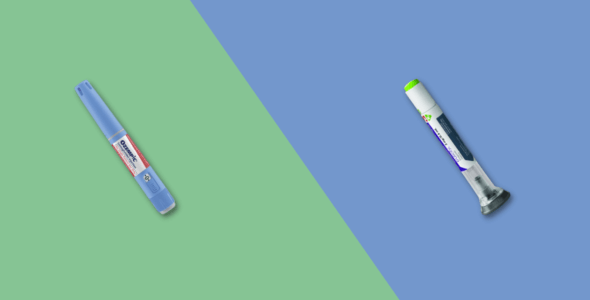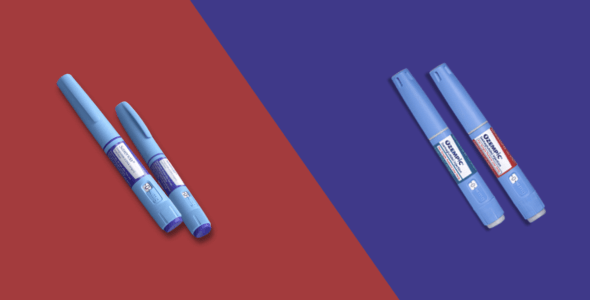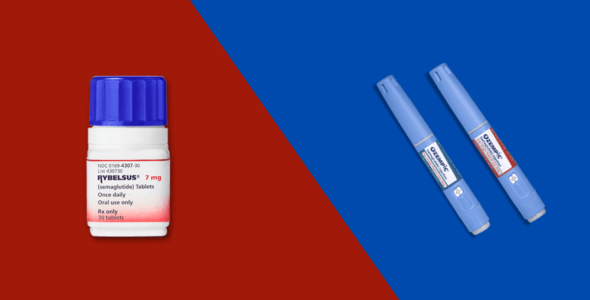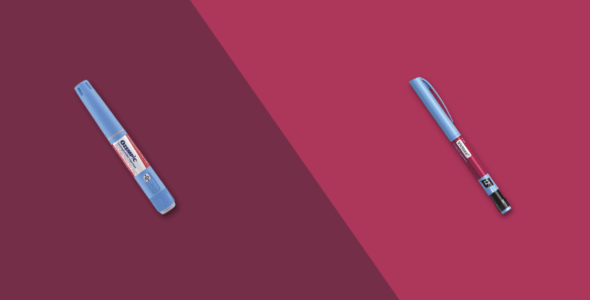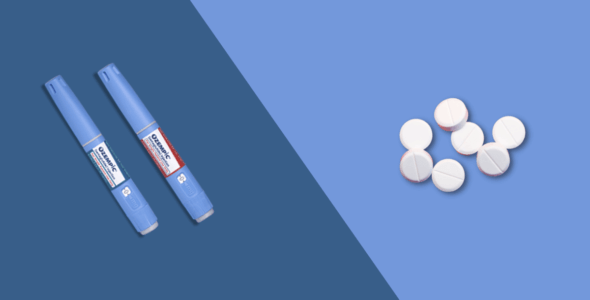Wegovy and Ozempic are produced by a Danish pharmaceutical company called Novo Nordisk and are delivered as weekly injections. Wegovy and Ozempic are brand-name drugs that both contain semaglutide, which is a glucagon-like peptide-1 receptor agonist. Glucagon-like peptide-1 is a hormone produced by the intestines in response to food intake and works in three main ways: controlling appetite, controlling blood sugar, and controlling intestinal movement. GLP-1 receptor agonists like Wegovy and Ozempic work by mimicking the natural GLP-1 hormone our bodies produce. As both medications are from the same drug class they have similar side effects and safety profiles. But what, exactly, do they do? Also why when they contain the same active ingredient are they used to treat different conditions? Medicines can have vastly different effects based on their dose and Wegovy and Ozempic are perfect examples of this. Read on to find out more.
What is Wegovy?
Wegovy is an FDA (U.S. Food and Drug Administration) approved weight loss drug. It is a higher-dose, 2.4 mg version of the diabetes drug Ozempic (semaglutide). Semaglutide is also manufactured in tablet form under the name Rybelsus.
Wegovy is a glucagon-like peptide-1 (GLP-1) receptor agonist indicated alongside a reduced-calorie diet and increased physical activity for chronic weight management in adult patients with a body mass index (BMI):
- 30 kg/m2 or greater (obesity)
- 27 kg/m2 or greater (overweight) in the presence of at least one weight-related comorbidity condition such as high blood pressure, type 2 diabetes mellitus, or high cholesterol
The STEP 1 study involved 1961 overweight or obese people who were given 2.4 mg of a semaglutide once-weekly injection alongside lifestyle intervention. The mean change in body weight from baseline to week 68 was 14.9% in the semaglutide group as compared with 2.4% with placebo.
What is Ozempic?
Ozempic is an FDA approved medication given to adults with type 2 diabetes to:
- Lower blood sugar (glucose) levels, when used alongside exercise and diet changes
- Reduce the risk of major cardiovascular events, like heart attacks and strokes, in people who have heart disease
Ozempic can help you lower your blood sugar levels when used alongside dietary and lifestyle changes. It causes you to secrete more insulin, helping to lower your blood sugar and reduce your risk of major cardiovascular events, like heart attacks and strokes, if you have heart disease.
In the SUSTAIN 7 study, it was found low and high doses of semaglutide were superior to dulaglutide (Trulicity) in improving blood sugar control and reducing body weight. This allowed a significantly greater number of patients with type 2 diabetes to achieve clinically meaningful glycaemic targets and weight loss, with a similar safety profile.
RELATED: Ozempic for weight loss
What doses of Wegovy are available?
Wegovy is available in prefilled injection form, in the following doses: 0.25 mg, 0.5 mg, 1 mg, 1.7 mg, or 2.4 mg.
Wegovy should be used once weekly, on the same day each week, at any time of day, with or without meals. Inject Wegovy subcutaneously in the abdomen, thigh, or upper arm.
Start at 0.25 mg once weekly for 4 weeks. Increasing the dose 4 weekly until a dose of 2.4 mg is reached. The maintenance dose of Wegovy is 2.4 mg once weekly.
See the full prescribing information for the complete boxed warning for Wegovy. You are recommended to read the medication guide and advised to always speak with your healthcare provider about any changes to your dose so they can monitor and evaluate your condition.
What doses of Ozempic are available?
Ozempic pens can be prescribed in 0.25 mg, 0.5 mg, and 1 mg doses.
Ozempic should be used once weekly, on the same day each week, at any time of day, with or without meals. Inject subcutaneously in the abdomen, thigh, or upper arm.
Start at 0.25 mg once weekly. After 4 weeks, increase the dose to 0.5 mg once weekly. If after at least 4 weeks additional glycemic control is needed, increase it to 1 mg once weekly.
This is only a guide as dosing schedules will be determined by your healthcare professional.
Injecting Wegovy and Ozempic
Wegovy and Ozempic are injected in the same way. You need to inject under your skin (subcutaneous injection) rather than into a vein or muscle. The fatty tissue just under your skin is the ideal place for the drug to be absorbed gradually. If you inject it deeper into your muscle your body will absorb it too quickly. The effects may not last long and will additionally be more painful. Judging the depth correctly can be quite difficult, particularly if you are slim but it is important to master the technique to stay safe.
The injection sites are the thigh, abdomen, or upper arm, these areas are likely to have enough body fat to allow you to easily inject. The importance of rotating injection sites should be noted to maintain effective drug absorption and prevent problems.
Which other drugs are GLP-1 receptor agonists?
GLP-1 receptor agonists include Bydureon, Byetta, Rybelsus (oral medication of Ozempic), Tanzeum, Victoza, and Saxenda (liraglutide).
Wegovy and Ozempic side effects
The most common side effects of Wegovy and Ozempic in clinical trials compared to placebo include:
- Nausea
- Diarrhea
- Constipation
- Abdominal pain
- Headache, dizziness
- Fatigue
- Dyspepsia, abdominal distension, eructation
- Hypoglycemia (low blood sugar) in patients with type 2 diabetes
- Flatulence, gastroenteritis, and gastroesophageal reflux disease (heartburn)
In rare instances, Wegovy and Ozempic can cause more serious side effects. These can include:
- Thyroid C-cell tumors
- Acute pancreatitis
- Acute gallbladder disease
- Hypoglycemia
- Acute kidney injury – monitor renal function when initiating or escalating doses if severe adverse gastrointestinal reactions occur
- Hypersensitivity
- Diabetic retinopathy complications in patients with type 2 diabetes
- Heart rate increase
- Suicidal behavior and ideation
Your doctor will assess the benefits of using Wegovy or Ozempic against your risk of side effects. Patients are encouraged to report negative side effects or adverse reactions of Wegovy and Ozempic to the FDA. Visit www.fda.gov/medwatch, or call 1-800-FDA-1088.
RELATED: Wegovy side effects, Ozempic side effects
Boxed warnings for Wegovy and Ozempic
Wegovy and Ozempic have a boxed warning by the FDA for thyroid cancer risk including medullary thyroid carcinoma (MTC). This was shown in rodent studies but it is unknown whether this can occur in humans. Patients with a history or family history of thyroid cancer, MTC, or with multiple endocrine neoplasia syndrome Type 2 (MEN 2) should not take Wegovy or Ozempic. MTC can start as a lump in the throat, and cause voice hoarseness, or windpipe pipe blockage.
Wegovy and Ozempic drug interactions
Ozempic can also interact with the following medications:
- Any medications you take orally to reduce the risk of blood clots (oral anticoagulants) like warfarin
- Insulin – Ozempic can be used alongside insulin, but your doctor may change the dose of insulin you take and/or how often you take insulin
- Any other medications taken to treat type 2 diabetes
This list is not exhaustive and other prescription drugs may interact with Wegovy and Ozempic. Tell your healthcare provider about all the medicines you take, including prescription and over-the-counter medicines, vitamins, and herbal supplements.
Wegovy and Ozempic warnings & precautions
Don’t take Wegovy or Ozempic if you:
- Are allergic to the active ingredient semaglutide, or any of the other ingredients in Wegovy or Ozempic
- Have had, or anyone in your family has had, a type of thyroid cancer called medullary thyroid carcinoma (MTC)
- Have an endocrine system condition called multiple endocrine neoplasia syndrome type 2 (MEN 2)
- Have pancreatitis
- Have type 1 diabetes (Ozempic is for type 2 diabetes only)
- Are under 18 years of age
Talk to your doctor before taking Wegovy or Ozempic if you:
- Have had any problems with your pancreas or kidneys
- Have ever had diabetic retinopathy
- Are pregnant or are planning to become pregnant
- Are breastfeeding or are planning to breastfeed
Wegovy and Ozempic are not the right fit for everyone. Your doctor may prescribe other medications based on your unique needs, medication you currently take, health history, and your health insurance coverage.

